Students develop games, build audiences in largest computer game course yet
Zach Champion • January 14, 2019
EECS 494 uses game design to teach its students broader lessons about iteration in software development

 Enlarge
EnlargeCourse instructor Austin Yarger, right, plays a group's final project at the EECS 494 Computer Games Showcase
×
The 2018 Computer Games Showcase flooded Tishman Hall with pirates, hard-hatted miners, and patriotic space war recruiters on December 11. Seniors in EECS 494, Computer Game Design and Development, and visiting students from Eastern Michigan University showed off their final group projects with live demos set up around the hall.
494 uses game design to teach its students broader lessons about iteration in software development. The course includes visiting lectures from game industry experts and two team projects and a solo project. The final group project requires the students to cover all phases of game development, including system conceptualization, specification, design, implementation, and evaluation. The students developed the games over six weeks using the Unity game engine.
Course instructor Austin Yarger wants students to come away with the ability to take feedback in stride and apply it in a slow-but-sure process of continuous improvement. In the end, each group should finish a game that is accessible and fun to a wide audience.
This year’s presentations were animated and frequently costumed, with many groups setting up props, displays, and costumes themed around their finished games. Attendees were able to hear presentations by the students about the games and had plenty of time before and after to try them out.
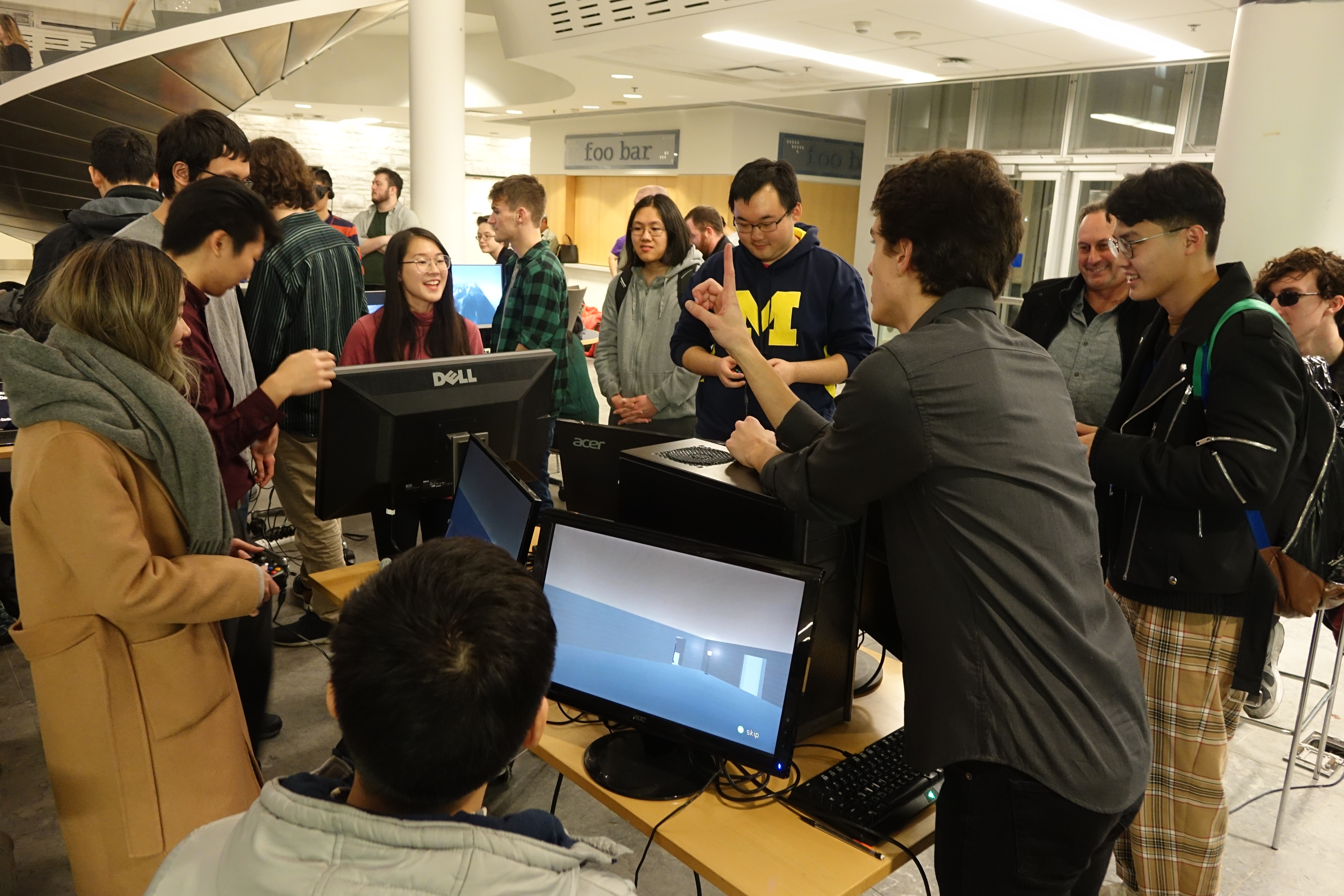
 Enlarge
Enlarge×
The addition of Eastern Michigan students to the event was a new idea this semester, says Yarger. “Teaming up with them propelled many of our games’ aesthetics to new levels of polish and charm,” he says, adding that the experience also gave the class experience with client-freelancer relationships.
Yarger also had the class experiment with a new submission procedure. As the students developed their games, they submitted development blogs to IndieDB.com. The popular site is a platform for small studios to promote their work and report on progress, and gave the class the opportunity to treat their project like a serious design undertaking for an audience.
“Many of our student games have hundreds of views and even some budding fan communities!” Yarger says. With luck, the course could turn out gaming startup companies in the future.
The chances aren’t bad either – the course’s popularity continues to climb, and this semester it even faced capacity issues. Yarger looks to address this in subsequent semesters, potentially by opening additional sections.
“494 had another incredible year,” Yarger says. “The students put tremendous effort into their work, and our community has felt the impact in the form of fantastic games.”
Read more about the students’ games:
Photo Gallery
 Astro Turf Wars by Reformed_Picnic_Jackals Studio
Battle it out as the Americans versus the Soviets to claim planets in this arcade-style space domination game. Grab asteroids with your claw gun and shoot them at your enemies to knock them off planets. Raise your flag over a planet to capture it and start earning points.
Astro Turf Wars by Reformed_Picnic_Jackals Studio
Battle it out as the Americans versus the Soviets to claim planets in this arcade-style space domination game. Grab asteroids with your claw gun and shoot them at your enemies to knock them off planets. Raise your flag over a planet to capture it and start earning points. Battle it out as the Americans versus the Soviets to claim planets in this arcade-style space domination game. Grab asteroids with your claw gun and shoot them at your enemies to knock them off planets. Raise your flag over a planet to capture it and start earning points.
Battle it out as the Americans versus the Soviets to claim planets in this arcade-style space domination game. Grab asteroids with your claw gun and shoot them at your enemies to knock them off planets. Raise your flag over a planet to capture it and start earning points. Buccaneer Booty Battle!
by Pear Gaming Studio
4 pirates. 4 boats. 2 teams. 1 chest. Some coins. Cannons, rowing and all the coins you can collect. Yarg, matey!
Buccaneer Booty Battle!
by Pear Gaming Studio
4 pirates. 4 boats. 2 teams. 1 chest. Some coins. Cannons, rowing and all the coins you can collect. Yarg, matey!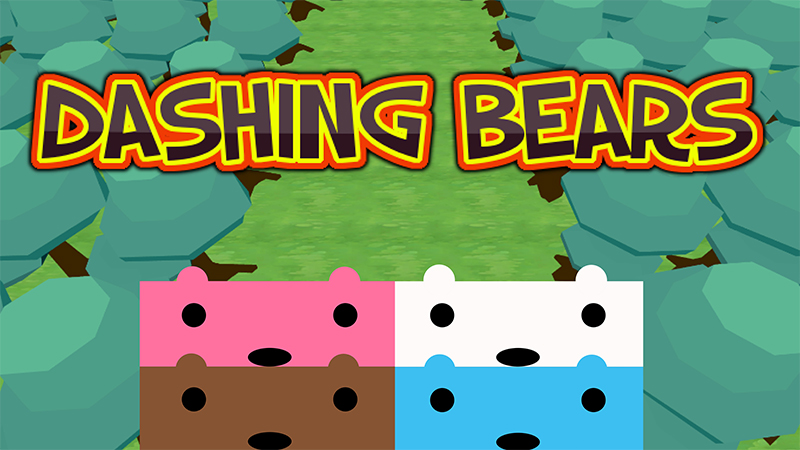 Dashing Bears
by Lucky Dragon's Den Studio
Dashing Bears is a four player racing, platform, and party game. The game features four different bears running in a forest, dodging obstacles and escaping from the hunters. The bears have to collect items during the fast pace running in order to boost themselves or even create more chaos for other bears.
Dashing Bears
by Lucky Dragon's Den Studio
Dashing Bears is a four player racing, platform, and party game. The game features four different bears running in a forest, dodging obstacles and escaping from the hunters. The bears have to collect items during the fast pace running in order to boost themselves or even create more chaos for other bears. Demo Smash
by Team Demo Smash Studio
Battle it out with fast action car combat. Prove victorious in the stadium.
Demo Smash
by Team Demo Smash Studio
Battle it out with fast action car combat. Prove victorious in the stadium.  Demolition Island
by Almost Above Average Games Studio
Demolition Island is an action packed car based oddball style game where four players fight to control the flag the longest! Players can pickup a variety of car parts along with rockets, landmines, and shields to help win the game!
Demolition Island
by Almost Above Average Games Studio
Demolition Island is an action packed car based oddball style game where four players fight to control the flag the longest! Players can pickup a variety of car parts along with rockets, landmines, and shields to help win the game!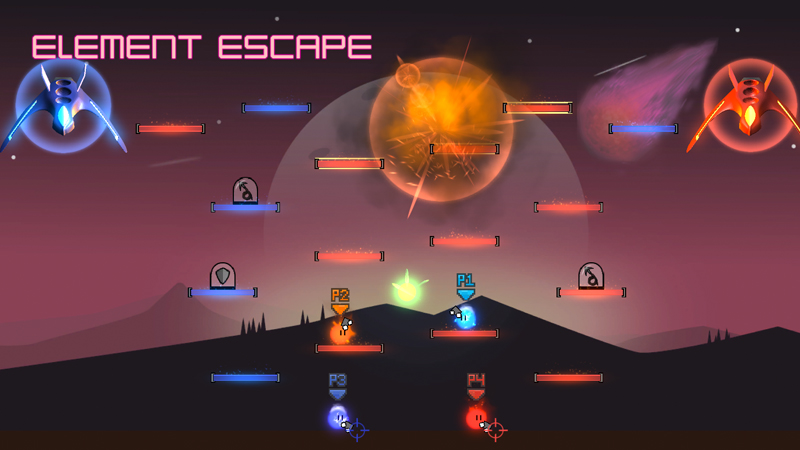 Element Escape
by Dog Gardens Inc. Studio
Element Escape is a fast-paced 4 player, 2v2 shooter-platformer! Players will be need to think quickly and act fast to bring the power cores to their ship and escape a crumbling planet.
Element Escape
by Dog Gardens Inc. Studio
Element Escape is a fast-paced 4 player, 2v2 shooter-platformer! Players will be need to think quickly and act fast to bring the power cores to their ship and escape a crumbling planet.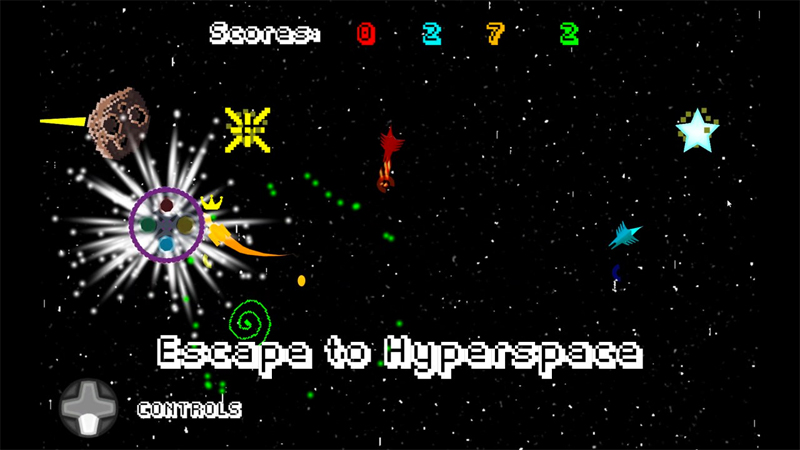 Escape to Hyperspace
by DABD Studios
Escape to Hyperspace is a four-player arcade shooter game where players are stuck in a deadly asteroid field and are looking for a hyperdrive to escape. A passing ship offers a hyperdrive, but to obtain it players must kill each other, bring coins to the ship, and finish with the highest bid.
Escape to Hyperspace
by DABD Studios
Escape to Hyperspace is a four-player arcade shooter game where players are stuck in a deadly asteroid field and are looking for a hyperdrive to escape. A passing ship offers a hyperdrive, but to obtain it players must kill each other, bring coins to the ship, and finish with the highest bid.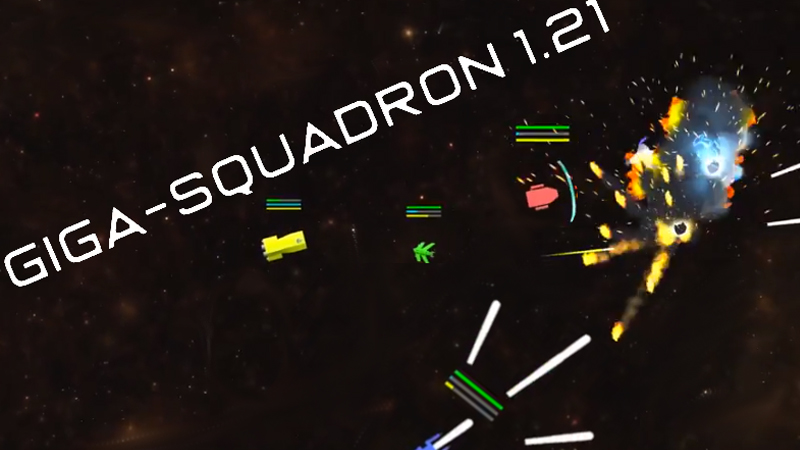 Giga-squadron 1.21
by Whats4Dinner Studio
Giga-squadron 1.21 is a high-speed, 4-player shoot 'em up game in which players work together as a team to destroy enemies and discover planets. Discover and liberate each planet to defeat the invading aliens!
Giga-squadron 1.21
by Whats4Dinner Studio
Giga-squadron 1.21 is a high-speed, 4-player shoot 'em up game in which players work together as a team to destroy enemies and discover planets. Discover and liberate each planet to defeat the invading aliens!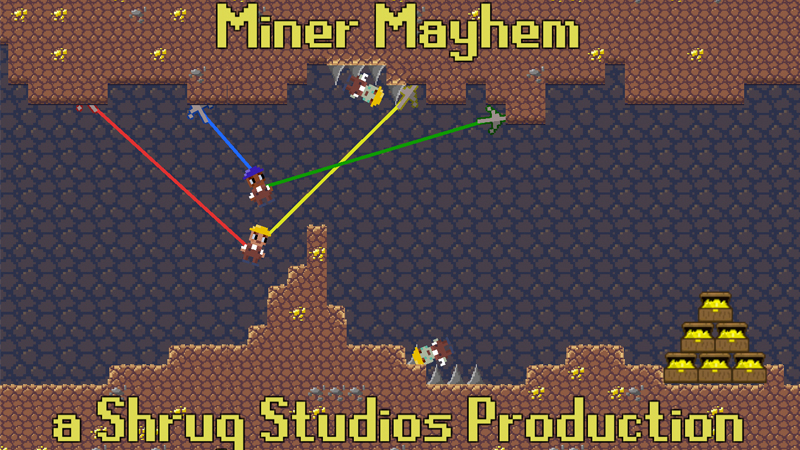 Miner Mayhem
by Shrug Studios Studio
Miner Mayhem is a four-player platformer racing game, where each team controls one miner speeding through an abandoned mine in search of gold coins, armed with nothing but grappling hooks, pickaxes, and non-functional legs.
Miner Mayhem
by Shrug Studios Studio
Miner Mayhem is a four-player platformer racing game, where each team controls one miner speeding through an abandoned mine in search of gold coins, armed with nothing but grappling hooks, pickaxes, and non-functional legs.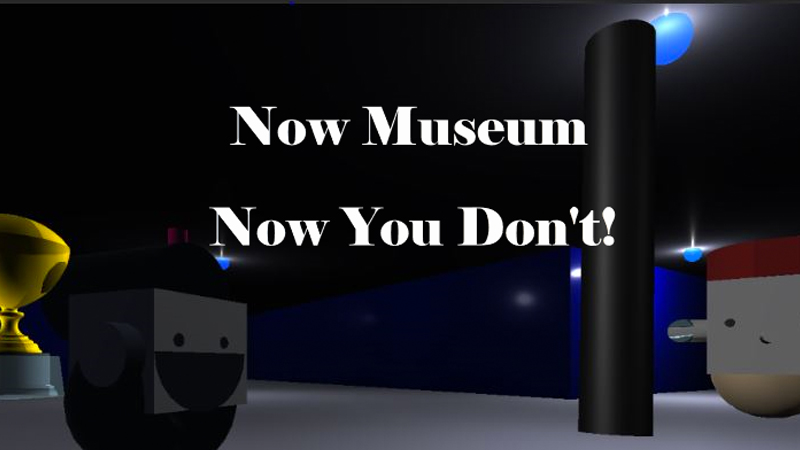 Now Museum, Now You Don't!
by Error Mob Studio
A thief tries to steal a trophy from a museum and escape while a guard tries to trap and catch him. In this stealth pvp game, 2 players are pitted against each other to see who can outwit the other.
Now Museum, Now You Don't!
by Error Mob Studio
A thief tries to steal a trophy from a museum and escape while a guard tries to trap and catch him. In this stealth pvp game, 2 players are pitted against each other to see who can outwit the other. Party Poopers
by Yeet! Studio
Party Poopers is a 2v2 multiplayer heist game in which one teammate is in a large house searching for a safe while the other operates cameras to help guide his partner around. Players must figure out the combination to the safe and beat the other team to the objective and escape through the front door to win.
Party Poopers
by Yeet! Studio
Party Poopers is a 2v2 multiplayer heist game in which one teammate is in a large house searching for a safe while the other operates cameras to help guide his partner around. Players must figure out the combination to the safe and beat the other team to the objective and escape through the front door to win.

 Enlarge
Enlarge

 Enlarge
Enlarge















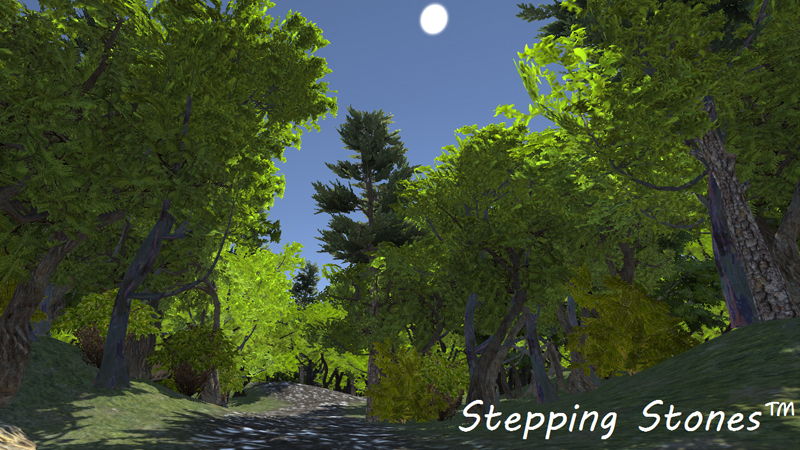
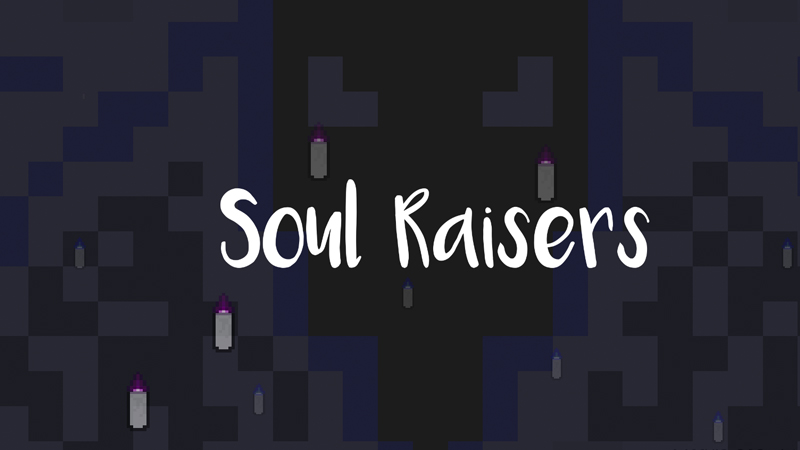
 MENU
MENU 
